Physical Address
304 North Cardinal St.
Dorchester Center, MA 02124
The normal sonographic appearance of the ovaries changes with the menstrual cycle because of the influence of gonadotropins. These changes cease to occur as late menopause is reached and developing follicles are no longer present.
Nonneoplastic lesions of the ovary and adnexa are usually simple cysts or cysts that contain blood products and are often physiologic. These include hemorrhagic physiologic cysts and endometriomas that can often be differentiated based on the sonographic appearance of the type of blood products. Other common nonneoplastic cysts include paraovarian cysts, hydrosalpinges, and peritoneal inclusion cysts.
Ovarian torsion, a condition caused by rotation of the ovarian pedicle on its axis, is a surgical emergency and sonography is valuable in making the diagnosis.
Morphologic and Doppler sonographic findings in neoplasms can be highly accurate in differentiating benign from malignant masses.
Sonography is the modality of choice for imaging the pelvis, including the adnexa, because it is noninvasive, radiation free, cost effective, and widely available. Sonography allows for accurate delineation of uterine and ovarian architecture and assessment of vascular flow. Transvaginal sonography (TVS) is a fundamental part of pelvic ultrasound examinations because of the use of higher frequency transducers (up to 10 MHz) and the vaginal probe's proximity to the uterus and adnexa. However, transabdominal sonography (TAS) continues to be the mainstay when structures are high in the pelvis, out of the field of view of the TVS probe; in pediatric patients; and in those who have difficulty tolerating TVS. Color and spectral Doppler sonography allow for assessment of normal and pathologic blood flow. Doppler ultrasound can also distinguish vascular structures from nonvascular structures, such as dilated fallopian tubes or fluid-filled bowel loops.
Bilaterally, the broad and round ligaments, fallopian tubes, ovaries and their associated vascularity extend from lateral uterine corpus forming the pelvic adnexa. Laterally, the peritoneal reflection forms the broad ligaments, which extend from the lateral aspect of the uterus to the lateral pelvic side walls ( Fig. 16.1 ). Encompassing the superior and lateral margin of the broad ligament is the suspensory (infundibulopelvic) ligament. The free border of the broad ligament contains the fallopian tube within its superior margin, which is referred to as the mesosalpinx. The ovary is attached to the posterior layer of broad ligament by reflections of peritoneum called the mesovarium. The round ligaments arise from the uterine cornua anterior to the fallopian tubes in the broad ligaments, extend anterolaterally, and course through the inguinal canals to insert into the fascia of the labia majora.
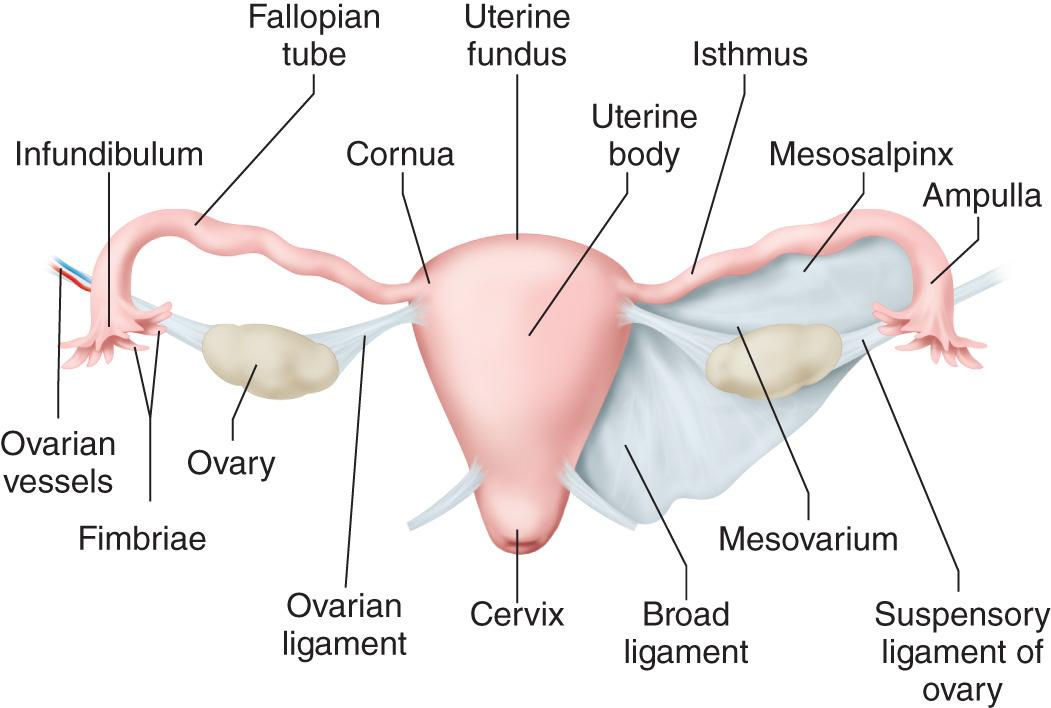
Each fallopian tube varies from 7 to 12 cm in length and is divided into intramural, isthmic, ampullary, and infundibular portions. The intramural, or interstitial, portion is approximately 1 cm long, is contained within the muscular wall of the uterus, and is the narrowest part of the tube. The isthmus, constituting the medial third, is slightly wider, round, cordlike, and continuous with the ampulla, which is tortuous and forms approximately one-half the length of the tube. The ampulla terminates in the most distal portion, the infundibulum, or fimbriated end, which is funnel shaped and opens into the peritoneal cavity.
The ovaries are elliptical in shape, with the long axis usually oriented vertically. The surface of the ovary is not covered by peritoneum but by a single layer of cuboidal or columnar cells called the germinal epithelium, which becomes continuous with the peritoneum at the hilum of the ovary. The internal structure of the ovary is divided into an outer cortex and inner medulla. The cortex consists of an interstitial framework, or stroma, which is composed of reticular fibers and spindle-shaped cells and which contains the ovarian follicles and corpus lutea. Beneath the germinal epithelium, the connective tissue of the cortex is condensed to form a fibrous capsule, the tunica albuginea. The medulla, which is smaller in volume than the cortex, is composed of fibrous tissue and blood vessels. In the nulliparous female, the ovary is located in a depression on the lateral pelvic wall called the ovarian fossa , which is bounded anteriorly by the obliterated umbilical artery, posteriorly by the ureter and the internal iliac artery, and superiorly by the external iliac vein. The fimbriae of the fallopian tube lie superior and lateral to the ovary. The anterior surface of the ovary is attached to the posterior surface of the broad ligament by the short mesovarium. The upper pole of the ovary is attached to the lateral wall of the pelvis by the lateral extension of the broad ligament, the suspensory (infundibulopelvic) ligament of the ovary. Arising from the uterine cornu posteriorly to the tubes and attaching to the inferior aspect of the ovary is the utero-ovarian ligament. These ligaments are not rigid, and therefore the ovary can be quite mobile, especially in women who have had pregnancies and/or who have had a hysterectomy.
The vascularity to the adnexa consists of a dual blood supply. The ovary is chiefly supplied by the ovarian artery, a branch of the hypogastric (internal iliac) artery but usually receives additional arterial flow from the ovarian branches of the uterine artery ( Fig. 16.2 ). The veins tend to parallel the arteries. From the ovarian pampiniform plexus, the right ovarian vein drains directly into the inferior vena cava, while the left ovarian vein empties into the left renal vein. The ovarian ligaments that include the broad ligament, the ovarian ligament, and the infundibulopelvic ligament contain vascular, lymphatic, and nervous supplies to the organs. The ovarian nerves and vessels course with the suspensory (infundibulopelvic) ligament and the utero-ovarian ligament. The lymph vessels of the ovary accompany the ovarian artery to the lateral aortic and periaortic lymph nodes. Coursing superior and adjacent to the utero-ovarian ligament that arises from the uterine cornu posteriorly to the tubes and attaches to the inferior aspect of the ovary in the utero-ovarian ligament is the ovarian branch of the uterine artery. Derived from the main ovarian artery and the ovarian branch of the uterine artery are numerous arterioles extending to the capsule of the ovary and small penetrating arteries within the ovary itself. The ovarian blood supply may vary from five to six branches that penetrate the capsule to two large branches with multiple twigs.
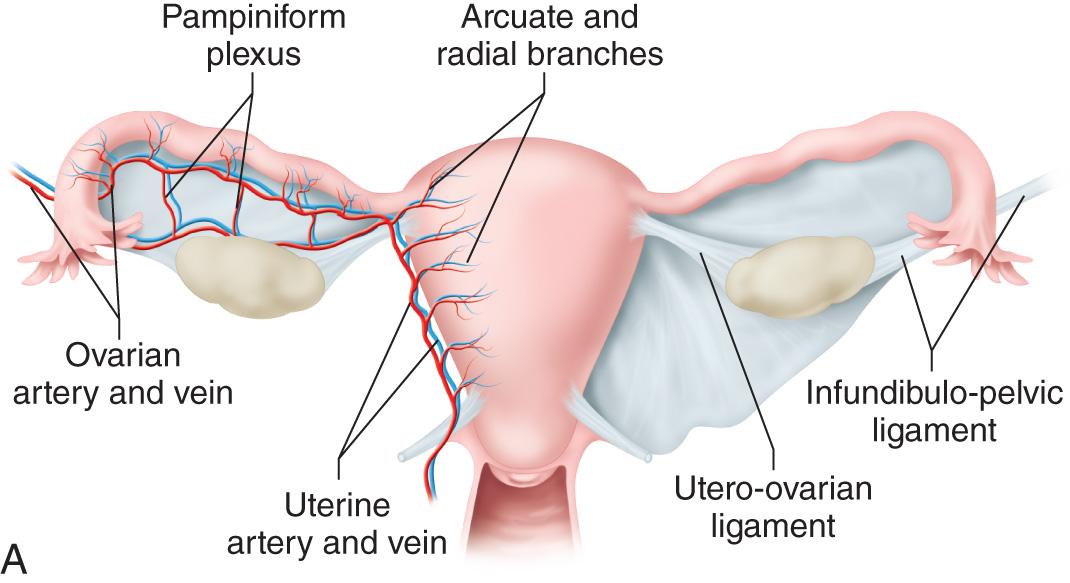
Although not considered part of the adnexal structures, the rectouterine recess (posterior cul-de-sac) is often involved in adnexal processes. It is the most posterior and inferior reflection of the peritoneal cavity and is located between the rectum and vagina and is also known as the pouch of Douglas. The posterior fornix of the vagina is closely related to the posterior cul-de-sac and is separated by the thickness of the vaginal wall and the peritoneal membrane. The cul-de-sac is a potential space, and because of its location, it is frequently the initial site for intraperitoneal fluid collection. As little as 5 mL of fluid has been detected by TVS.
The standard examination of the pelvic adnexa is included in the routine pelvic sonogram and is composed of the traditional TAS combined with the TVS, frequently using color and spectral Doppler. TAS uses a distended bladder as window to pelvic structures for a global view and may be advantageous when ovaries are high in the pelvis, outside of the field of view of the TVS probe. However, using TAS, visualization of pelvic organs may be limited because of attenuation from the body wall and the distance from the area of interest of the transducer. As a result, it is not often possible to use higher frequency transducers and benefit from their inherent higher axial and lateral resolution. TVS gives a more detailed evaluation of adnexal architecture using higher frequency transducers at closer proximity to pelvic structures and should be used whenever feasible. Still, TVS should not be performed in premenarchal patients, in the majority of virginal patients, or in any patient who does not willingly consent to vaginal examination. Because TVS is typically performed, routine bladder distention is not required unless there is a reason for additional TAS images, or unless the woman declines vaginal scanning. Initial imaging with TAS is performed using the patient’s bladder distention at presentation followed by a full TVS. When TVS is not going to be performed, then we require a full bladder for best visualization of the uterus, endometrium, and adnexa.
TVS with abdominal compression is a valuable technique for improving adnexa visibility. Abdominal pressure with one hand, while holding the transducer with the other hand, is used to displace bowel, bring structures closer to the transducer, and identify focal areas of tenderness. The pressure of the transducer between two adjacent structures in the pelvis can be used to determine if they move together or slide past each other as separate entities. This is often referred to as the “sliding organ sign.” Examples of the value of this technique include its use to confirm that an adnexal mass is unattached to the ovary or a mass is ovarian and not uterine in origin.
Spectral and color and power Doppler are routinely used to characterize vascularity to the ovaries and fallopian tubes, helping to narrow the differential considerations. This is especially useful when there is suspicion of neoplasia or in patients presenting with pelvic pain with diagnostic considerations that include pelvic inflammatory disease (PID), ovarian torsion, or functional cysts. Because color or power Doppler signal may be produced artifactually, it is important to always confirm flow by demonstrating a spectral waveform.
The ovary can be quite variable in position and may be located high in the pelvis or in the cul-de-sac because of the laxity of the ligamentous attachments. Uterine location influences the position of the ovaries. The normal ovaries are usually identified laterally or posterolaterally to the anteflexed midline uterus. When the uterus lies to one side of the midline due to exogenous pressure by a mass or a normal variant, the ipsilateral ovary often lies superior to the uterine fundus. In a retroflexed uterus, the ovaries tend to be located laterally and superiorly, near the uterine fundus. When the uterus is enlarged, the ovaries may be displaced more superiorly and laterally. After hysterectomy, the ovaries tend to be located more medially and directly superior to the vaginal cuff. A common location of the ovaries, especially in nulliparous patients, is Waldeyer fossa. In this location, the ellipsoid configuration of the ovary has its craniocaudad axis paralleling the internal iliac vessels, which lie posteriorly and serve as a helpful reference ( Fig. 16.3 ). Waldeyer fossa is also bounded by the obliterated umbilical artery anteriorly, the ureter posteriorly, and the external iliac vein superiorly. Superiorly or extremely laterally placed ovaries may not be visualized by the TVS approach because they may be outside of the field of view of the TVS probe.

Because of the variability in shape, ovarian volume has been considered the best method for determining ovarian size. The volume measurement is based on the formula for a prolate ellipse (0.523 × length × width × height). In women of reproductive age, a normal ovary may have a volume as large as 22 mL. Cohen et al. assessed 866 normal ovaries by TAS and reported a mean ovarian volume of 9.8 ± 5.8 mL, with an upper limit of 21.9 mL. Another study of 406 patients with normal ovaries used TVS and reported a mean ovarian volume of 6.8 mL, with an upper limit of 18.0 mL. There is no significant parity-related change in ovarian volume in premenopausal women.
Punctate echogenic foci are commonly seen in an otherwise normal-appearing ovary ( Fig. 16.4 ). Many are tiny (1-3 mm) nonshadowing foci, usually multiple and peripherally located, although they can be diffuse. Kupfer et al. examined five patients with peripherally distributed echogenic ovarian foci who subsequently underwent bilateral oophorectomy for other clinical indications. All 10 ovarian specimens showed multiple surface epithelial inclusion cysts and associated psammomatous calcifications. In another study with histopathologic correlation in seven normal ovaries with echogenic foci, Muradali et al. showed that these foci are caused by a specular reflection from the walls of tiny unresolved cysts below the spatial resolution of ultrasound rather than calcification. These echogenic foci do not indicate significant underlying disease, so no further investigation or follow-up is necessary. Brandt et al. reported that echogenic foci with associated shadowing consistent with focal calcification may occasionally be seen in an otherwise normal-appearing ovary. At histologic analysis, 4 of 17 ovaries analyzed (24%) were associated with benign neoplasms, whereas the remaining ovaries were unremarkable. It was proposed that these represent stromal reaction to previous hemorrhage or infection. Zeligs et al. recently reported echogenic ovarian foci with atypical morphologic characteristics and distribution in addition to extraovarian echogenic foci. These proved to be calcifications associated with a serous borderline ovarian tumor with extraovarian noninvasive implants. This finding is unusual, however, as the vast majority of punctate ovarian calcifications without associated mass are of benign etiology. When there is an associated mass or morphology or distribution of calcifications is atypical, additional imaging is recommended.
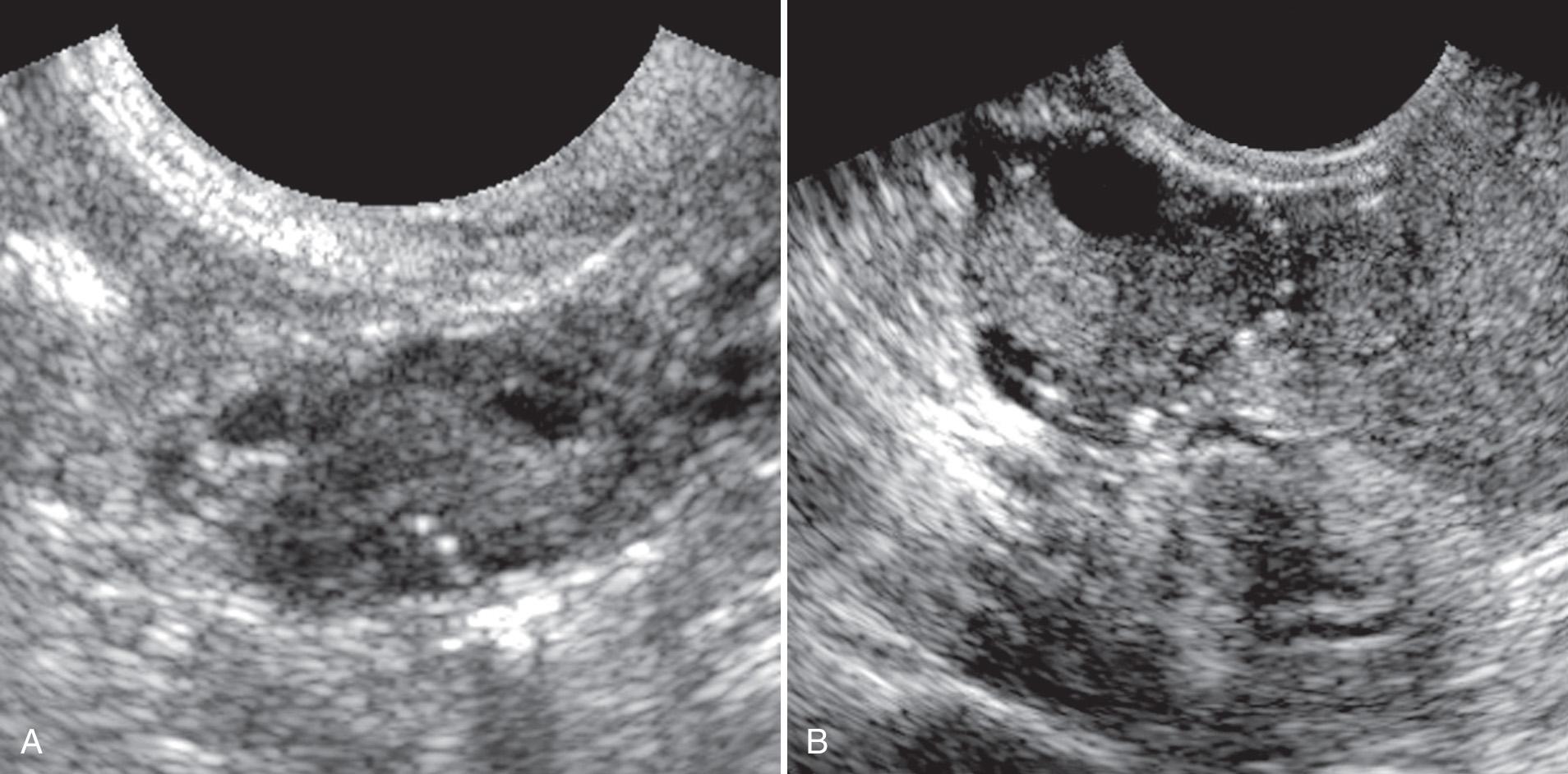
The fallopian tubes are musculomembranous structures measuring up to 12 cm in length and consisting of the intramural, isthmic, and ampullary portions. Although documentation of fallopian tubes is not a routine part of a normal pelvic examination, at least a portion of each tube can be demonstrated in most patients. Sonographically, the length of the fallopian tube can be identified by its tubular structure containing a linear echogenic lumen that can be followed to the uterine cornua.
The appearance of the ovary changes with age and phase of the menstrual cycle. Under the influence of follicle-stimulating hormone (FSH), human follicular development begins with a follicular size of approximately 0.03 mm with potential ovulation after more than 150 days of growth. It is only after follicles reach approximately 4 mm that they are routinely visualized by ultrasound. During the menstrual cycle, multiple immature, less than 1-cm follicles appear in the early follicular phase before day 10. Subsequently, one or more ovulatory follicles become dominant, increasing in size to 18 to 25 mm in average diameter. The average size of the dominant follicle is 20 mm in diameter at ovulation, which usually occurs on day 14 of a normal 28-day menstrual cycle. The other follicles become atretic. The disappearance of the dominant follicle with associated free fluid in the pelvis signifies ovulation. Other, less specific and sensitive findings may include irregularity of the cyst wall with internal echoes. A follicular cyst develops if ovulation does not occur and follicular growth continues because of the lack of the luteinizing hormone surge and excessive stimulation by FSH.
Following release of the ovum and collapse of the dominant follicle, the postovulatory corpus luteum is formed, a crenulated thick-walled cyst demonstrating peripheral color Doppler signal. The corpus luteum may bleed internally as a result of vascularization of the inner granulosa layer following ovulation forming a hemorrhagic corpus luteum (see Fig. 16.3C and D ). As the corpus luteum ages, it collapses and progressively transforms into a more solid, fatty structure, a corpus albicans, usually not well visualized sonographically. However, if pregnancy ensues, the corpus luteum continues to be maintained for hormonal support until approximately 10 to 13 weeks' gestation when placental hormone production can support the pregnancy.
Fluid in the cul-de-sac ( Fig. 16.5 ) is a normal finding in asymptomatic women and can be seen during all phases of the menstrual cycle. Possible sources include blood or fluid caused by follicular rupture, blood from retrograde menstruation, and increased capillary permeability of the ovarian surface caused by the influence of estrogen. Pathologic fluid collections in the pouch of Douglas may be seen in association with generalized ascites, blood resulting from a ruptured ectopic pregnancy or hemorrhagic cyst, or pus from infection. Sonography can aid in differentiating the type of fluid, because blood, pus, mucin, and malignant exudates usually contain echoes within the fluid, whereas serous fluid (either physiologic or pathologic) is usually anechoic. Clotted blood may be very echogenic, mimicking a solid mass.
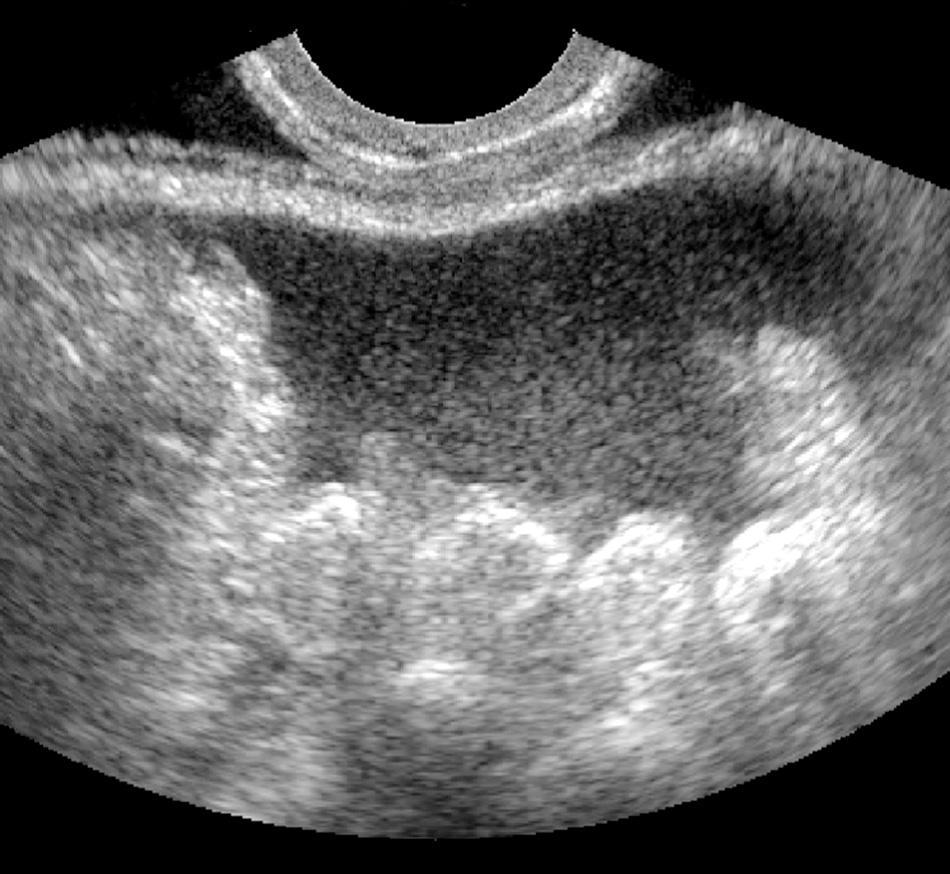
Differentiation of perimenopause and early postmenopause is often difficult. The postmenopausal period begins when at least 1 year or more has elapsed since the final menstrual period. In early postmenopause (1 to 5 years since final menstrual period) ovulatory cycles may occur infrequently and folliculogenesis may continue. Once late postmenopause is reached (more than 5 years since final menstrual period), folliculogenesis ceases, the ovary atrophies, and the follicles disappear, with the ovary decreasing in size with increasing age. Because of its smaller size and lack of follicles, the postmenopausal ovary may be difficult to visualize sonographically (see Fig. 16.3E and F ). A stationary loop of bowel may be mistaken for a normal ovary; therefore scanning must be done slowly to look for peristalsis (Video 16.1 ). However, because the colon does not always peristalse during a sonographic exam, lack of peristalsis is not sufficient for differentiation. Sonographic visualization of normal postmenopausal ovaries varies greatly in the literature, from a low of 20% to a high of 99%, using either the TAS or TVS. The variation is likely caused by differences in technique and length of time since menopause, and the series with very high percentages of visualization likely include some loops of bowel rather than ovaries. The ovary decreases in size with increasing age, and therefore the ability to see the ovaries decreases as the length of time since menopause increases. Also, the absence of the uterus may play a role in the visualization of ovaries that are less likely to be seen following hysterectomy because of the loss of normal anatomic landmarks.
In 290 postmenopausal ovaries known to be present, Wolf et al. visualized only 41% of ovaries through use of TVS, 58% through use of TAS, and 68% using both techniques. Highly placed ovaries may be out of the field of view of TVS transducers, and TAS may not image very small or deeply placed ovaries. Although nonvisualization of an ovary does not exclude an ovarian lesion, it can be a fairly reassuring finding since most ovarian neoplasms are cystic, and an ovarian mass will usually displace adjacent bowel loops and be more easily visible.
Mean postmenopausal ovarian volume ranges are reported from 1.2 to 5.8 mL. The mean values in these studies may be somewhat high because nonvisualized ovaries were not included. One study assessing 563 patients with normal postmenopausal ovaries by TVS reported a mean ovarian volume of 2.0 mL with an upper limit of normal of 8.0 mL. A postmenopausal ovarian volume of more than 8.0 mL should be considered abnormal. Because normal size varies widely, some authors suggest that an ovarian volume more than twice that of the opposite side should also be considered abnormal.
As patients progress from early to late menopause, small simple cysts, defined as thin-walled, round or oval anechoic cysts with posterior acoustic enhancement, no internal solid component or septation, and no internal color Doppler flow, become less frequently observed. While follicles may still be present in the early menopause, other cysts may be paraovarian or paratubal in origin or ovarian surface epithelial inclusion cysts.
One report suggests that simple cysts of all sizes may be seen in up to 15% of postmenopausal ovaries and are not related to age, length of time since menopause, or hormone use ( Fig. 16.6 ). Smaller cysts are more frequently seen by TVS with its improved resolution, but in some women, especially those with hysterectomy or highly placed ovaries, the cysts may be seen only by TAS. Most of these cysts either disappear or decrease in size over time. Other reports suggest that even in late menopause, when folliculogenesis is unlikely, small simple cysts are seen in up to 21% of women.
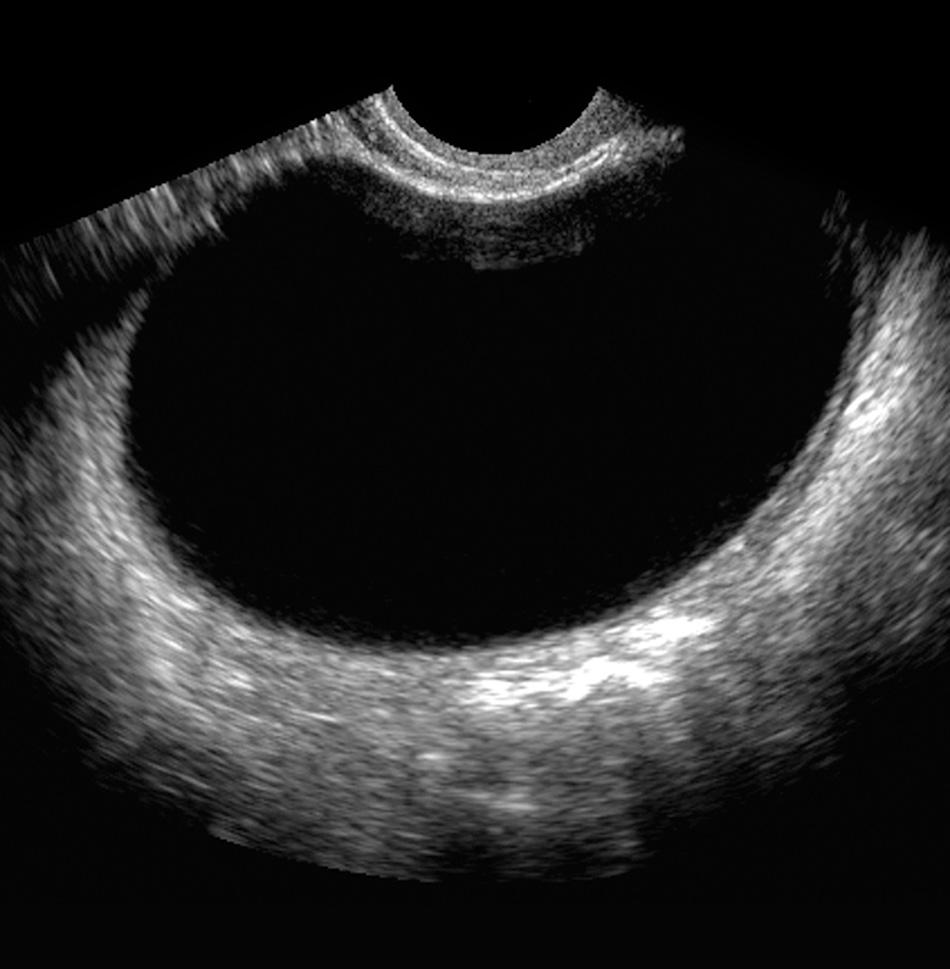
Several studies have shown a very low incidence of malignancy in unilocular postmenopausal cysts less than 5 cm in diameter and without septations or solid components. In surgical lesions that are inclined to be larger cysts and/or those in postmenopausal patients, 84% of simple ovarian cysts have been found to be cystadenomas. Although it has been shown that an ovarian cystadenoma may be a precursor of borderline tumors (those of low malignant potential and low-grade carcinomas), there is an extremely slow rate of transformation so that these lesions can be considered benign and are safe to watch over time rather than remove surgically. Ekerhovd et al. found four borderline or malignant tumors in 247 postmenopausal women (1.6%) who underwent surgery for simple ovarian cysts detected by TVS. These four tumors were all greater than 7.5 cm in diameter. It is generally recommended that asymptomatic postmenopausal women with simple ovarian cysts less than 7 cm and greater than 1 cm in diameter be followed by serial yearly sonographic examinations without surgical intervention unless there is an increase in size or change in the characteristics of the lesion. Cysts measuring less than 1 cm are felt to be almost certainly benign and follow-up is not necessary. Surgery is usually recommended for postmenopausal simple cysts greater than 7 cm and for those containing multiple internal septations or one or more solid nodules. However, magnetic resonance imaging (MRI) is better able to characterize these larger cysts in which small mural nodules can be missed by ultrasound and thus may be a reasonable alternative to surgery.
Functional cysts are physiologic and not neoplastic lesions of the ovary whose appearance and disappearance is hormonally driven. These cysts may be simple or hemorrhagic and are commonly divided into three categories: follicular, corpus luteum, and theca lutein cysts. Acute abdominal pain caused by internal hemorrhage, rupture, or leakage is the most common symptom, but pelvic discomfort may simply be the result of the large size, greater than 2.5 to 3.0 cm.
A follicular cyst develops when a mature follicle fails to ovulate or to involute. Because normal follicles can vary from a few millimeters up to 2.5 cm, a follicular cyst cannot be diagnosed with certainty until it is larger than 2.5 cm. Therefore a simple cyst less than 2.5 cm in a premenopausal woman should be referred to as a follicle and considered to be normal. Follicles and follicular cysts are usually unilateral, asymptomatic, and frequently detected incidentally on sonographic examination. Follicular cysts usually regress spontaneously.
After ovulation, the corpus luteum develops and may be identified sonographically as a small, hypoechoic or isoechoic structure within the ovary. The corpus luteum usually contains low-level internal echoes, frequently with a thicker wall than a follicle and a crenulated appearance. It typically has a peripheral rim of color around the wall on color Doppler ultrasound (ring of fire; see Fig. 16.3C ). The corpus luteum usually involutes before menstruation but may persist because of failure of absorption or internal bleeding. Timor-Tritsch and Goldstein recommend using the term corpus luteum rather than corpus lutein cyst unless it is greater than 4 cm. Corpus lutein cysts are less common than follicular cysts but tend to be larger and more symptomatic. Pain is the major symptom. These cysts are usually unilateral and are prone to hemorrhage and, less commonly, rupture. If the ovum is fertilized, the corpus luteum continues as the corpus luteum of pregnancy, which may become enlarged with a simpler cystic appearance than the original corpus luteum. Maximum size is reached at 8 to 10 weeks of gestation, and by 16 weeks the cyst has usually resolved.
Theca lutein cysts are associated with high beta–human chorionic gonadotropin (B-hCG) levels and are the largest of the functional ovarian cysts, increasing the risk of ovarian torsion. These cysts typically occur in patients with gestational trophoblastic disease but can also be seen as a complication of drug therapy for infertility causing ovarian hyperstimulation syndrome. Sonographically, theca lutein cysts are usually bilateral, multilocular, and very large. Similar to other functional cysts, they may undergo hemorrhage or rupture.
Although hemorrhage may occur in all types of functional cysts, it is most frequently seen in corpus luteal cysts. Women with hemorrhagic cysts frequently present with acute onset of pelvic pain. Hemorrhagic cysts show a spectrum of findings because of the variable sonographic appearance of blood ( Fig. 16.7 , Video 16.2 ). The appearance depends on the amount of hemorrhage and the time of the hemorrhage relative to the time of the sonographic examination. The internal architecture is much better appreciated on TVS when compared to TAS because of its superior resolution. An acute hemorrhagic cyst is usually hyperechoic and may mimic a solid mass. However, it usually has a smooth posterior wall and shows posterior acoustic enhancement, indicating the cystic nature of the lesion. Diffuse low-level internal echoes may be appreciated, although this appearance is more frequently seen in endometriomas. As the clot hemolyzes, a reticular-type pattern is demonstrated internally containing intertwining linear internal echoes representing fibrin strands. These should not be confused with septations, which are thicker. As the clot retracts, it will have a concave outer margin with angularity compared with a solid mural nodule, which will have a convex outer margin. Color Doppler ultrasound will show no flow within the clot but will demonstrate peripheral vascularity within the cyst wall. Care should be taken when assessing for flow in hemorrhagic cysts, because a clot can move and show color without true vascularity. Spectral Doppler can be helpful in these cases. Patel et al. found that a specific diagnosis could be made in approximately 90% of hemorrhagic cysts by demonstrating the presence of a reticular pattern or a retractile clot. The presence of echogenic, free intraperitoneal fluid in the cul-de-sac helps confirm the diagnosis of a leaking or ruptured hemorrhagic cyst. Rupture or leakage of a hemorrhagic cyst with associated peritoneal irritation in the setting of a positive serum B-hCG level may mimic a ruptured ectopic pregnancy, both clinically and sonographically.
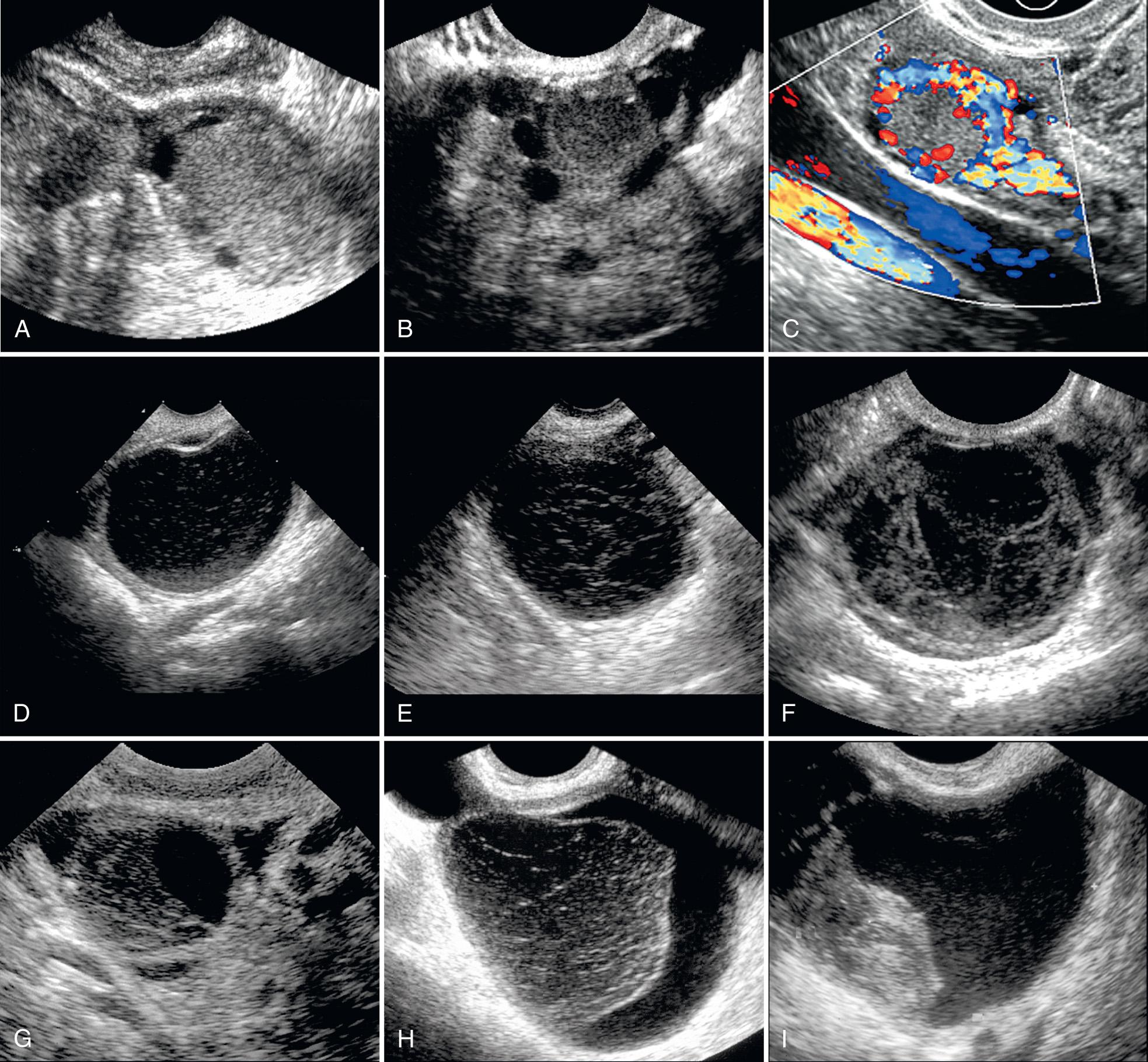
Functional cysts are the most common cause of ovarian enlargement in young women. Because these cysts typically resolve within one to two menstrual cycles, follow-up is usually not required for small, simple cysts or typical hemorrhagic cysts less than 5 cm in asymptomatic patients. However, follow-up of larger cysts and those in symptomatic patients can be performed following a normal menstrual cycle, usually in 6 weeks. Because ultrasound may be unable to identify small mural nodules within larger cysts, surgical intervention or further characterization using MRI is generally recommended for cysts greater than 7 cm.
Infrequently, a cystic mass may be encountered in a patient who has undergone bilateral oophorectomy due to a small amount of residual ovarian tissue has been unintentionally left behind. The surgery has usually been technically difficult because of adhesions from endometriosis, PID, or tumor. The residual ovarian tissue can develop functional cysts and produce pelvic pain and/or extrinsic compression of the distal ureter. Sonographically, the cysts vary in size and can be both simple and hemorrhagic. A thin rim of ovarian tissue is usually present in the wall of the cyst.
Ovarian lesions associated with pregnancy include hyperstimulated ovaries, ovarian hyperstimulation syndrome, theca lutein cysts, hyperreactio luteinalis, and the rare luteoma of pregnancy. Most are related to the normal or abnormal response to serum hCG levels. Hyperstimulated ovaries are a normal response to elevated circulating levels of hCG. Ovarian hyperstimulation is most common in women undergoing ovulation induction. Sonographically, the ovaries are enlarged with multiple cysts, some of which may be hemorrhagic. The enlarged ovaries may undergo torsion. They usually regress spontaneously during the pregnancy.
The term ovarian hyperstimulation syndrome (OHS) is used when the hyperstimulation is accompanied by fluid shifts ( Fig. 16.8 ). Clinically, three degrees of OHS are described: mild, moderate, and severe. The mild form is associated with lower abdominal discomfort, but no significant weight gain. The ovaries are enlarged, but less than 5 cm in average diameter. Moderate OHS presents with weight gain of 5 to 10 pounds and ovarian enlargement 5 to 12 cm. The patient may have nausea and vomiting. With severe OHS, there is weight gain of more than 10 pounds and the patient typically has severe abdominal pain and distention. The ovaries are greatly enlarged (>12 cm in diameter) and contain numerous large, thin-walled cysts, which may replace most of the ovary. The associated ascites and pleural effusions may lead to depletion of intravascular fluids and electrolytes, resulting in hemoconcentration with hypotension, oliguria, and electrolyte imbalance. Severe OHS is usually treated conservatively to correct the depleted intravascular volume and electrolyte imbalance and usually resolves within 2 to 3 weeks.
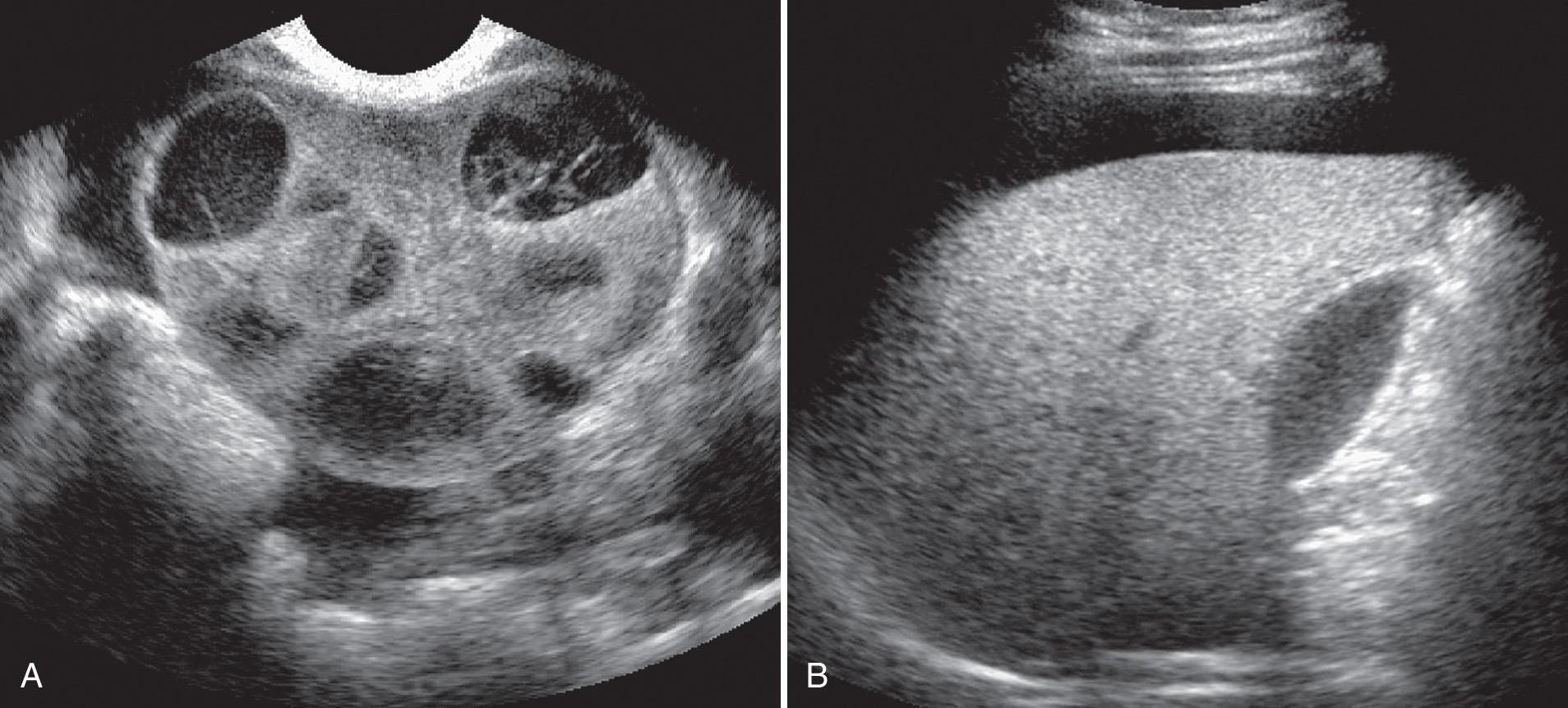
Theca lutein cysts are the largest of the functional ovarian cysts and are associated with high hCG levels. These cysts typically occur in patients with gestational trophoblastic disease. However, theca lutein cysts are typically not seen in first-trimester diagnosis of gestational trophoblastic disease, because the hCG level will not have been sufficiently high for a long enough time for them to develop. Theca lutein cysts can also be seen in OHS as a complication of drug therapy for infertility. Sonographically, theca lutein cysts are usually bilateral, multilocular, and very large. They may undergo hemorrhage, rupture, and torsion.
Hyperreactio luteinalis is caused by an abnormal response to circulating hCG in the absence of ovulation induction therapy. Approximately 60% of hyperreactio luteinalis cases occur in singleton pregnancies with normal circulating levels of hCG. Hyperreactio luteinalis usually occurs in the third trimester or less often in the puerperium. The majority of patients are asymptomatic, although maternal virilization may be seen in up to 25% of patients. The incidence of hyperreactio luteinalis increases in women with polycystic ovarian disease. In contrast to OHS, body fluid shifts are rare. Sonographically, there are bilaterally enlarged ovaries with multiple cysts similar to OHS, although the ovaries tend not to be as large and the condition occurs later in pregnancy. Hyperreactio luteinalis is a self-limited condition that resolves spontaneously.
Luteoma of pregnancy is the only solid mass in this group of pregnancy-related processes. It is a rare benign process unique to pregnancy that is due to stromal cells that may become hormonally active, producing androgens and replacing the normal ovarian parenchyma. Most patients are asymptomatic, although maternal virilization may occur in up to 30%. These patients have a 50% risk of virilization of the female fetus. Sonographically, luteomas usually present as nonspecific, heterogeneous, predominantly hypoechoic masses that may be highly vascular. An ovarian mass in a pregnant patient with signs of virilization should suggest this diagnosis, because luteoma is the most common cause of maternal virilization during pregnancy. Surgery is not indicated since the condition resolves spontaneously, typically after delivery.
Surface epithelial inclusion cysts are nonfunctional cysts usually seen in postmenopausal women, although they may be seen at any age, and are usually located peripherally in the cortex. They arise from cortical invaginations of the ovarian surface epithelium. When very small, the cysts themselves may not be seen, but rather they may appear as punctate echogenicities in the surface of the ovary. Although usually tiny, unilocular, and thin walled, these cysts can measure up to several centimeters in diameter. Occasionally, surface epithelial inclusion cysts may be hemorrhagic, particularly if torsion has occurred.
Paraovarian and paratubal cysts are wolffian or müllerian duct remnants in the mesosalpinx, often located superior to the uterine fundus. They are generally epithelium-lined simple cysts, rarely multiloculated or containing small wall nodularities. Echoes may also be occasionally seen with the cyst sonographically because of hemorrhage. They show no cyclic changes. There is an estimated incidence of 3%, accounting for about 10% to 20% of all adnexal masses. Typically, these cysts are small but may range in size up to 8 cm. They may occur at any age but are most commonly visualized in the third and fourth decades. Most are asymptomatic although patients with large cysts may have pelvic pain or the cysts may act as a fulcrum for torsion. A specific diagnosis of a paraovarian cyst is possible only by demonstrating a normal ipsilateral ovary adjacent to, but separate from, the cyst.
Benign neoplasms such as cystadenomas and cystadenofibromas of paraovarian origin are uncommon. Malignancy has been reported in 2% to 3% of parovarian cystic masses on histopathologic examination, although it occurs even less often in masses smaller than 5 cm.
Peritoneal inclusion cysts are seen in patients with peritoneal adhesions, occurring mostly in premenopausal women with a history of previous abdominal surgery, but they may also be seen in patients with a history of trauma, PID, or endometriosis. In patients with peritoneal adhesions, fluid produced by the ovary (which is the main producer of peritoneal fluid in women ) may accumulate within the adhesions and entrap the ovaries, resulting in an adnexal mass. Peritoneal inclusion cysts are lined with mesothelial cells. Clinically, most patients present with pain and/or a pelvic mass.
On sonography, peritoneal inclusion cysts are multiloculated cystic adnexal masses, often with a bizarre shape frequently described as a spider web pattern ( Fig. 16.9 ). The diagnostic finding is the presence of an intact ovary positioned eccentrically amid septations and fluid. The septations represent mesothelial and fibrous strands. The fluid is usually anechoic but may contain echoes in some compartments as a result of hemorrhage or proteinaceous fluid. Doppler evaluation may demonstrate vascularity within septations, at times mimicking a malignancy.
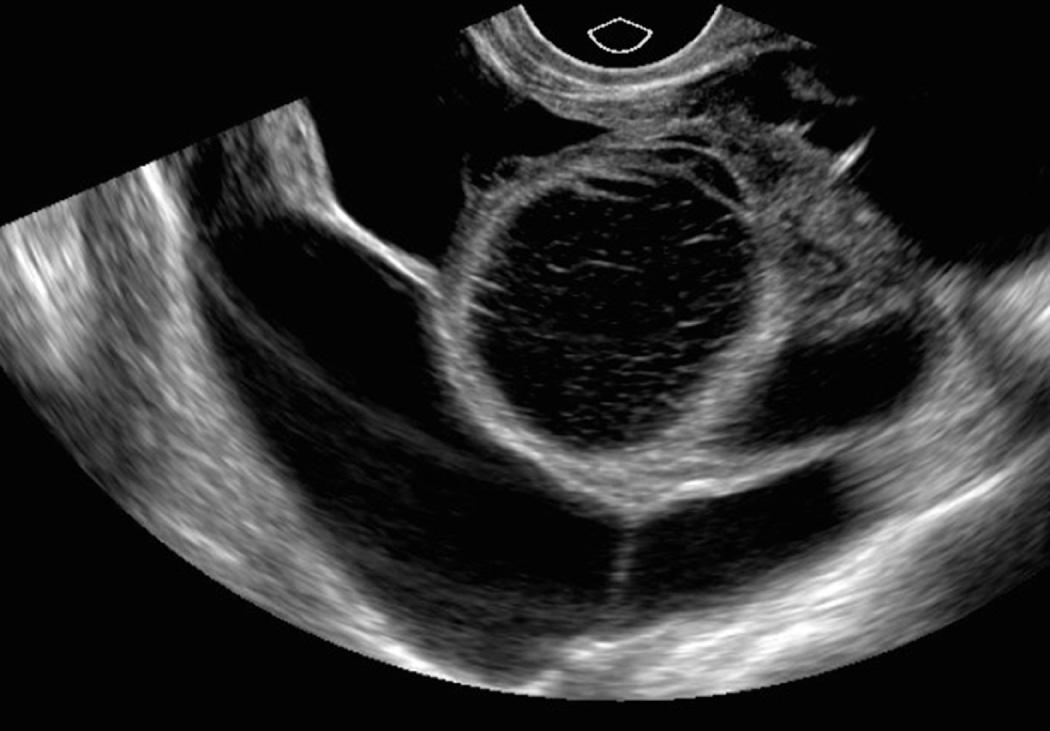
Peritoneal inclusion cysts must be differentiated from other extraovarian conditions such as parovarian cysts and a hydrosalpinx. Paraovarian cysts are separate from the ovary, whereas the ovary lies inside a peritoneal inclusion cyst. Parovarian cysts are usually round or ovoid and not associated with a history of pelvic surgery, trauma, or inflammation. A hydrosalpinx appears as a tubular or ovoid cystic structure often with visible folds, and the ovary is demonstrated as a separate entity. Accurate diagnosis of peritoneal inclusion cysts is important because the risk of recurrence after surgical resection is 30% to 50%. Conservative therapy, such as ovarian suppression with oral contraceptives or fluid aspiration, is recommended.
Polycystic ovarian syndrome (PCOS) is now known to be a multifaceted endocrinologic disorder of ovarian dysfunction that includes abnormal estrogen and/or androgen production resulting in chronic anovulation and hyperandrogenism. Pathologically, the ovaries contain an increased number of follicles in various stages of maturation and atresia, and increased local concentration of androgens produces stromal abnormality. PCOS is a common cause of infertility and a higher-than-usual rate of early pregnancy loss. Clinical manifestations of PCOS range from mild signs of hyperandrogenism in thin, normally menstruating women to the classic Stein-Leventhal syndrome (oligomenorrhea or amenorrhea, hirsutism, and obesity).
The typical sonographic findings of PCOS are bilaterally enlarged ovaries containing multiple small, 2- to 9-mm follicles and increased stromal echogenicity ( Fig. 16.10 ). The ovaries have a rounded shape, with the follicles usually located peripherally (“string of pearls”), although they can also occur randomly throughout the ovarian parenchyma. Because of its superior resolution, TVS is more sensitive than TAS in detecting the small follicles. However, many women with PCOS will not have these typical sonographic findings. Ovarian volume may be normal in 30% of patients. Using TVS, increased stromal echogenicity has also been reported as a sensitive and specific sign of polycystic ovaries. In a small number of patients, the sonographic findings may be unilateral.
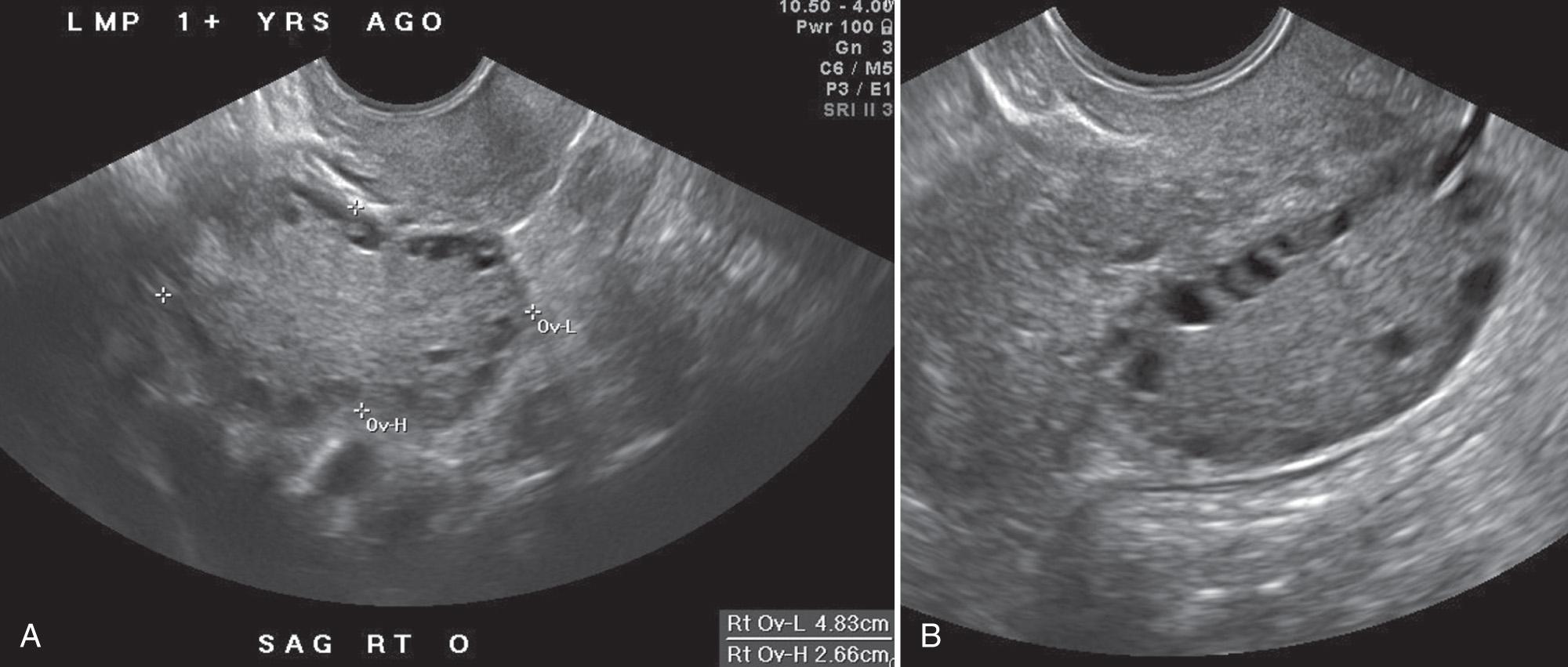
A 2003 consensus meeting of the American Society for Reproductive Medicine and European Society of Human Reproduction and Embryology defined PCOS as requiring two of three criteria: (1) oligo-ovulation and/or anovulation, (2) hyperandrogenism (clinical and/or biochemical), and (3) polycystic ovaries. An elevated serum luteinizing hormone (LH) level and insulin resistance have also been characteristic features. Historically, an elevated serum LH level and elevated LH/FSH ratio had been used as diagnostic tools. However, based on data that include the variability of LH depending on proximity to ovulation and its questionable importance in management, recommendations no longer support its necessity for clinical diagnosis.
According to decisions made at the 2003 Rotterdam consensus workshop, the sonographic findings of polycystic ovaries should include either 12 or more follicles within the entire ovary measuring 2 to 9 mm in diameter or increased ovarian volume greater than 10 mL. Although increased stromal echogenicity has been considered specific for polycystic ovaries, because of its subjective nature it was not included in the criteria. The consensus makers thought that measurement of ovarian volume worked as well as stromal evaluation in clinical practice. These criteria are not considered valid if the patient is taking oral contraceptives or has a dominant follicle greater than 10 mm. More recently, it has been reported that with the use of newer, higher resolution ultrasound technology and an offline reliable grid system to count follicles, a significantly higher follicle count threshold within the entire ovary is necessary to support the diagnosis of PCOS. Lujan et al. advocated the use of a count of 26 and Christ et al. a count of 28 follicles measuring 2 to 9 mm within the entire ovary as a better predictor of PCOS.
Because anovulation plays a key role in this disorder, the follicles will persist on serial studies. Long-term follow-up is recommended in patients with PCOS because the resulting high-unopposed estrogen levels can be associated with an increased risk of endometrial and breast carcinoma.
Become a Clinical Tree membership for Full access and enjoy Unlimited articles
If you are a member. Log in here